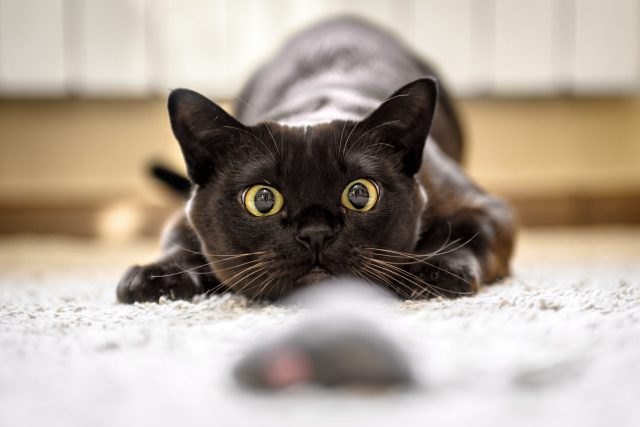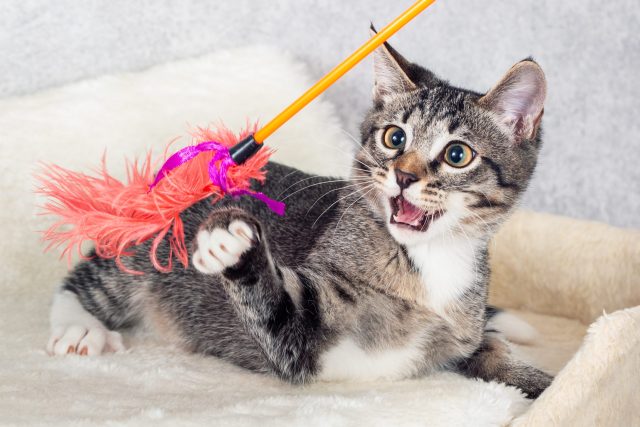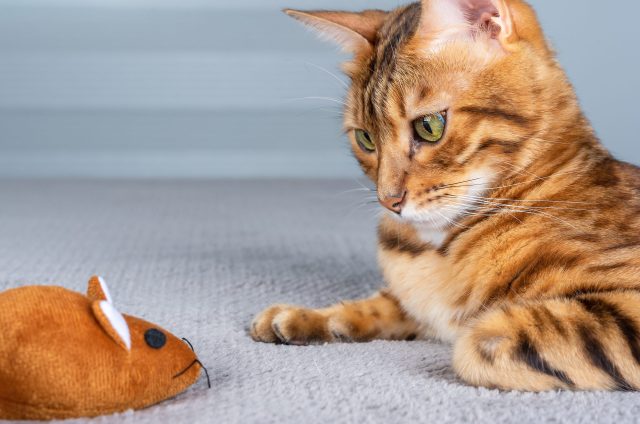Did you know lions have a prey preference for buffalo, wildebeest, and zebra? Did you also know your cat has a prey preference too? Maybe your wild hunter isn’t stalking the African plains, but they certainly have a partiality regarding what they enjoy hunting.
And these preferences can vary across kitties, from domesticated cats that indulge in games with catnip-filled mice to outdoor ones stalking birds in the backyard. This natural instinct to hunt is encoded deeply into a cat’s DNA, stretching back to their wild ancestors. And just like us, cats can like and dislike things. But how do you identify your cat’s prey preference, and why is this important?

What is Prey Preference in Cats?
Prey preference in cats refers to the type of prey a cat is most attracted to or likely to hunt. This may not necessarily be based on what they want to eat but on what stimulates their predatory instincts. Each cat may have different preferences based on various factors such as their environment, individual personality, and past experiences.
Identifying Your Cat’s Preference
Identifying your cat’s prey preference shouldn’t be hard. You can easily spot what your cat prefers in hunting by observing their play habits. Domestic cats, despite having their meals served, still hold a strong instinctual drive to hunt. Playtime for them often mimics the hunting behaviors of their wild ancestors, and the toys they most prefer often give a clue to their prey preference.
If your cat frequently chooses to play with feathered toys, they may prefer bird-like prey. They may opt for mammalian game like mice or squirrels if they show more interest in ground-based toys that scurry or make erratic movements.
This observation can also extend beyond play. Outdoor cats may bring their successful hunts home. This can range from small mammals to birds or insects. The type of prey they consistently catch and bring home indicates their preference. It’s also worth noting that some cats may prefer stationary or slow-moving prey, like worms or insects, especially if they are older or less agile.
RELATED: Why Your Cat Needs To Play

Tips on How to Identify Your Cat’s Prey Preference
Here are some fun and practical tips to help identify your cat’s prey preference:
- Toy Time: Provide a variety of toys that mimic different types of prey, such as feathered toys, mouse-shaped toys, or toys that move erratically. Observe which ones your cat gravitates towards the most.
- Use Sounds: Some toys have sound mechanisms that mimic the noise made by birds or rodents. Your cat’s response to these sounds can reveal much about their prey preference.
- On the Hunt: For outdoor cats, take note of any “gifts” your cat may bring home. These are usually the best indicator of their natural prey preference.
- Rotating Toy Collections: Regularly swap out your cat’s toy collection to keep them interested and see if their preference changes based on variety.
- Interactive Play: Engage with your cat using toys on strings or wands that mimic the movement of different animals. Pay attention to their level of enthusiasm and engagement with each type.
- Bug Watch: Watch your cat’s behavior around insects in the home. Some cats are particularly captivated by things that flutter or scuttle.
- Bird Watching: Place a bird feeder outside a window where your cat can watch. Observe their interest level – do they watch intently, or are they disinterested?
- Fishing Games: Try using toys that mimic fish movement to see if your cat has an interest in aquatic prey.
- Use Tech: Cat apps and videos are designed to simulate different types of prey. Test them out to see which your cat seems most interested in.
- Catnip Test: Some toys come filled with catnip, and while it’s not necessarily related to prey preference, a cat’s interest level can still indicate what form or style of toy they might prefer.
Remember, each cat is unique, so what works for one might not work for another. It’s all about observing your cat and understanding their unique interests and behaviors.

Why Understanding Prey Preference Is Important
Understanding your cat’s prey preference has several advantages. Firstly, knowing your cat’s prey preference allows you to provide them with toys that mimic their favorite prey, which can result in more engaged and satisfying play sessions. It can also help you understand your cat’s behavior, especially if they’re an outdoor cat. This can help with their safety, as knowing what kind of animals they are likely to chase can help you better prepare or protect them.
Secondly, understanding prey preference can help cat parents reduce the impact their little hunter may have on local wildlife. Cats can have a significant effect on local bird populations, and if you discover your cat has a strong preference for birds, you may want to take steps to deter this behavior. This could include keeping your cat indoors during certain times of day when birds are most active or providing bird-safe zones in your garden.
RELATED: How to Keep Your Kitty Happy Indoors

Like the majestic lions on the African plains, your feline friend has their own unique hunting preferences. By taking the time to observe and understand these preferences, you can ensure a happier, healthier, and safer life for your kitty. This insight into their world deepens the bond between you and your domesticated predator.

